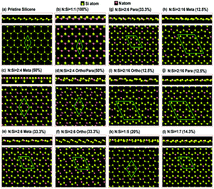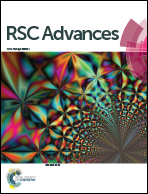Unusual features of nitrogen substitutions in silicene
Abstract
The quasiparticle properties resulting from charge and spin are clearly identified in nitrogen-substituted silicenes, for which a theoretical framework is successfully developed from first-principles calculations. Such systems create extremely non-uniform chemical and physical environments through the distribution of the guest atoms. They present unusual geometric, electronic, and magnetic properties, which can be identified from the optimal honeycomb lattices, the atom- and spin-dominated energy spectra, the spatial charge density distributions, and the atom-, orbital- and spin-projected van Hove singularities [the net magnetic moments]. The complicated relations between the highly hybridized sp2-N–Si bonds and the ferromagnetic/non-magnetic configurations are responsible for the p-type or semiconducting behavior, the significant modifications to the Dirac cone structures, the difficulty in identifying the π and σ bands, and the vanishing or finite magnetic moments. The theoretical predictions could be verified by high-resolution experimental measurements.



 Please wait while we load your content...
Please wait while we load your content...